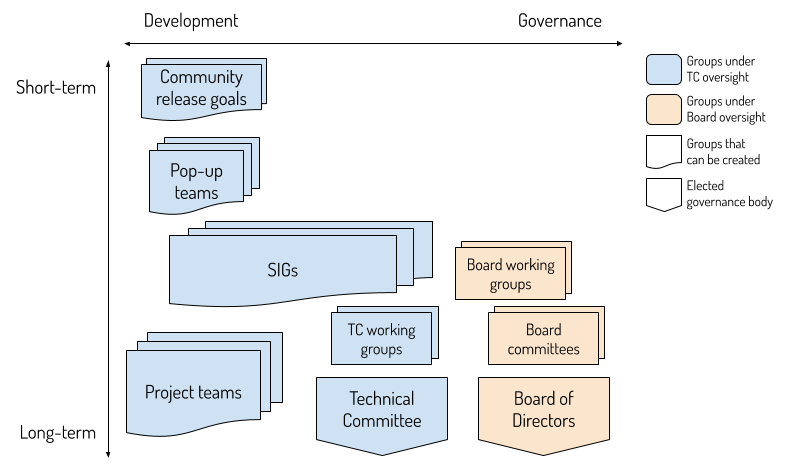Doing this is useful since we lack human-readable web pages to point to when answering the question: "What repositories are under OpenStack TC's governance charter?" Change-Id: I5672a7f0ce3de32d8fc0577fee8354552d2962ce
7.2 KiB
Comparison of Official Group Structures
This document aims to compare the various official work groups we have in OpenStack, and explain the difference between a community goal, project team, SIG (special interest group), working group, pop-up teams... If you are still unsure, even after you read through this document, please raise your question on the mailing-list or on IRC: #openstack-tc so people might be able to help you.
Groups can be organized around two axis: whether they address a long-term or short-term mission, and whether that mission is more around development or governance. Missions in OpenStack are either under the oversight of the Board of Directors (trademark, Foundation affairs) or the Technical Committee (open source project).
Project teams
Project teams </reference/projects/index> are
responsible for producing the "OpenStack" software releases. They are
either producing a specific subset of OpenStack deliverables (like
Compute service deliverables), or provide functions that are integral to
the production of the software (like Release management or QA).
Project teams are under the oversight of the TC, and traditionally lead by PTLs (project team leaders). Since their collective output is assembled to make the "OpenStack" coordinated releases every 6 months, extra accountability is required of project teams to make OpenStack as a whole reach high quality standards. In particular, we require named liaisons for deliverable release management, security vulnerability management, and QA/CI infrastructure liaison.
Beyond that, project teams own git repositories, review proposed code changes, manage bug reports, answer questions on the mailing-list, define the future roadmap for their deliverables, and help communicate recent changes. To that effect, team members hold regular team meetings and participate in various community events.
OpenStack has a large number of existing project teams. if you would
like to create a new project team, you can reference new projects requirements </reference/new-projects-requirements>
documentations for more details.
Special Interest Groups (SIGs)
SIGs are groups with a long-term mission, but which are not directly responsible for producing components of the "OpenStack" software release. They usually gather like-minded individuals that want to advance a specific facet of OpenStack (like usage of OpenStack in scientific communities) that extends beyond a limited set of code repositories. They generally regroup developers, operators and end users interested in the same topics. Some of those topics are very development oriented (like enabling support for multiple architectures), while some others are more governance-oriented (like helping first-time contributors).
SIGs are under the oversight of the TC, and traditionally lead by a number of co-leads. Since they are not directly in charge of producing OpenStack, only limited accountability is required, and SIGs do not have any required named liaisons.
SIGs can own git repositories </reference/sig-repos>
and produce software, but that software will be considered add-on
software to the main "OpenStack" software releases. Therefore SIGs
deliverables are not part of the coordinated release, and will not
leverage the openstack/releases repository. If a SIG does release any
tooling or software they are responsible for any release
management/tagging needed.
You can check for process to create a SIG for creating a new SIG.
Pop-up teams
Pop-up teams are lightweight structures aiming to provide quick start for short term (time-limited) cross-project mission. In particular, pop-up teams should have a disband criteria: an end status goal at which point the pop-up team should be disbanded. These cross-project and time-limited aspects are what differentiates them from Project teams or SIGs.
Pop-up teams are under the oversight of the TC, and traditionally lead by a number of co-leads. Since they are not directly in charge of producing OpenStack, only limited accountability is required, and pop-up teams do not have any required named liaisons.
Pop-up teams do not own code repositories, they usually work on code repositories from existing project teams to reach their goals.
You can read more about the process to create a pop-up team in popup team guideline </reference/popup-teams> if
you consider to create one.
Community goals
Community goals </goals/index> are per-release
objectives, set by the Technical Committee for all project teams. Those
are used to achieve user-visible common changes, push for basic levels
of consistency and user experience, and efficiently improve certain
areas which suffer from technical debt. The main difference with pop-up
teams is that it's a time-limited scope rather than an objective-limited
scope, and they generally aim at affecting all project teams rather than
a limited set of them.
Community goals are driven by goal champions and executed in each project team. They do not require specific git repositories or deliverables.
If you have an improvement which affects projects OpenStack-wide,
then you can propose it as a community goal. The Technical Committee
will be responsible for selecting community goal </goals/index> for each
cycle.
Technical Committee and TC working groups
The Technical Committee (TC) is an elected governance body, representing all contributors to the open source project.
It may delegate rights (and duties) to TC working groups (like the Election officials which have a delegation for running elections).
The TC owns git repositories (generally around governance documents)
</reference/technical-committee-repos> but does not produce
OpenStack deliverables by itself.
Board of Directors, Board committees and working groups
The Foundation Board of Directors is a governance body, representing all Foundation members. It is composed of three tiers: Platinum representatives (selected by each Platinum member), Gold representatives (elected among the Gold members), and Independent representatives (elected by all the individual members of the Foundation).
The Board of Directors has oversight over the Foundation, whose mission is to develop, support, protect, and promote OpenStack and other Open Infrastructure projects.
It may delegate rights (and duties) to Board committees and working groups, which are usually staffed by directors themselves.
